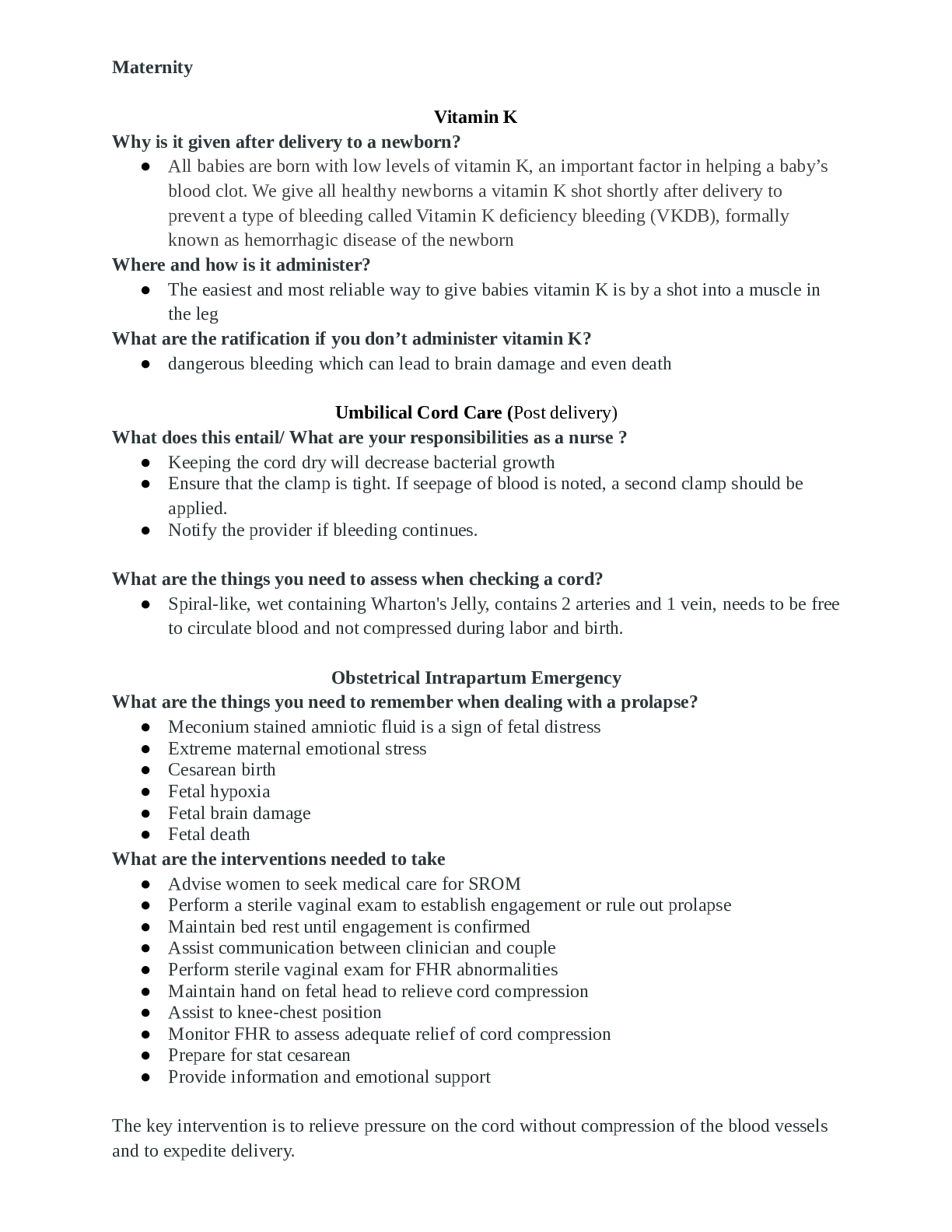Health Care > STUDY GUIDE > NU 345A Complete Maternity Study Guide. (All)
NU 345A Complete Maternity Study Guide.
Document Content and Description Below
NU 345A Complete Maternity Study Guide. Why is it given after delivery to a newborn? ● All babies are born with low levels of vitamin K, an important factor in helping a baby’s blood clot. We gi... ve all healthy newborns a vitamin K shot shortly after delivery to prevent a type of bleeding called Vitamin K deficiency bleeding (VKDB), formally known as hemorrhagic disease of the newborn Where and how is it administer? ● The easiest and most reliable way to give babies vitamin K is by a shot into a muscle in the leg What are the ratification if you don’t administer vitamin K? ● dangerous bleeding which can lead to brain damage and even death Umbilical Cord Care (Post delivery) What does this entail/ What are your responsibilities as a nurse ? ● Keeping the cord dry will decrease bacterial growth ● Ensure that the clamp is tight. If seepage of blood is noted, a second clamp should be applied. ● Notify the provider if bleeding continues. What are the things you need to assess when checking a cord? ● Spiral-like, wet containing Wharton's Jelly, contains 2 arteries and 1 vein, needs to be free to circulate blood and not compressed during labor and birth. Obstetrical Intrapartum Emergency What are the things you need to remember when dealing with a prolapse? ● Meconium stained amniotic fluid is a sign of fetal distress ● Extreme maternal emotional stress ● Cesarean birth ● Fetal hypoxia ● Fetal brain damage ● Fetal death What are the interventions needed to take ● Advise women to seek medical care for SROM ● Perform a sterile vaginal exam to establish engagement or rule out prolapse ● Maintain bed rest until engagement is confirmed ● Assist communication between clinician and couple ● Perform sterile vaginal exam for FHR abnormalities ● Maintain hand on fetal head to relieve cord compression ● Assist to knee-chest position ● Monitor FHR to assess adequate relief of cord compression ● Prepare for stat cesarean ● Provide information and emotional support The key intervention is to relieve pressure on the cord without compression of the blood vessels and to expedite delivery. Newborn Jaundice Difference physiologic and pathologic ? ● When the total serum bilirubin (TSB) level reaches 5 to 7 mg/dL, jaundice is visible in the face ● TSB includes both direct (conjugated) and indirect (unconjugated) bilirubin. …Jaundice moves down the body as the bilirubin levels continue to rise. ● Jaundice is considered abnormal or nonphysiologic when the TSB level rises more rapidly and to a higher level than is expected or stays elevated for longer than normal. ● BTW… most hospitals around the country do test every newborn for bilirubin levels. No Chances! Difference in severity ? ● This may lead to acute bilirubin encephalopathy, the acute manifestation of bilirubin toxicity. This may lead to kernicterus, the chronic and permanent result of bilirubin toxicity. How are they treated differently ? ● Treatment: Phototherapy and Exchange Transfusion ● Maintaining a neutral thermal environment ● Providing optimal nutrition ● Protecting the eyes ● Enhancing response to therapy ● Detecting complications ● Teaching parents Assess risk for jaundice. Ensure infant is feeding well. Explain the condition to parents. Premature delivery interventions What are the things we can do to try to give this baby respiratory success? ● Positioning ● The prone position is used for preterm infants because it decreases breathing effort and increases oxygenation ● corticosteroids Feeding the Newborn Breast vs bottle Full-term breastfed infants 85-100 kcal per kg (39-45 kcal per lb) daily Exclusive breastfeeding for the first 6 months Continued breastfeeding with the addition of foods until 12 months of age Formula fed infants 100-110 kcal per kg (45-50 kcal per lb) daily What are the important things (heating?) Don't heat, just warm. Too much heat can destroy the milk's enzymes and immunizing properties, so simply warm the bottle gently before giving to baby. If breast milk is frozen, run the bottle under some warm water to defrost it Should not be heated in the microwave Should be diluted exactly according to directions [Show More]
Last updated: 2 years ago
Preview 1 out of 13 pages

Buy this document to get the full access instantly
Instant Download Access after purchase
Buy NowInstant download
We Accept:

Reviews( 0 )
$10.00
Can't find what you want? Try our AI powered Search
Document information
Connected school, study & course
About the document
Uploaded On
Jun 22, 2021
Number of pages
13
Written in
Additional information
This document has been written for:
Uploaded
Jun 22, 2021
Downloads
0
Views
50














